If you’re a fan of ornamental grasses and looking to establish a new addition in your landscape, pampas grass should be a strong candidate. This large-growing perennial flowering plant is famed globally for its sizeable and colourful blade-like fluffy feathery flowers that burst from its grass-like foliage beneath.
The long linear foliage arches gently, creating an attractive form within gardens. Here is everything you need to know to grow and care for pampas grass.
More...
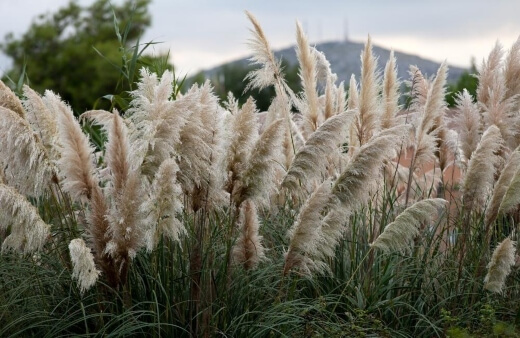
Genus: | Cortaderia |
|---|---|
Species: | C. selloana |
Family: | Poaceae |
Common Names: | Pampas grass |
Location: | Outdoor |
Type: | Perennial flowering plant |
Growth: | 1.5 to 3 metres tall and wide |
Sun requirements: | Full sun to partial shade |
Foliage Colour: | Green |
Flower Colour: | Pink, yellow or white |
Flowering: | Late summer through autumn |
Maintenance level: | Low |
Poisonous for pets: | Non-toxic to cats and dogs |
Getting to Know Pampas Grass
With all of its ornamental features, this plant can easily add colour, texture and interest to your outdoor spaces. It is considered easy to grow and features many hardy qualities so it is a great choice for novice and expert growers alike.
It is important to note that this plant self-seeds rapidly where it can quickly become invasive within landscapes, hogging up space and resources. But, if you care for it well and establish it in the right location, this grassy decorative plant is certainly worth it.

Cortaderia selloana or pampas grass forms a part of the Poaceae family of flowering plants and is native to southern South America, including the Pampas region after which it is named.
Naturally, this plant thrives in hot and humid climates, being a very fast-growing, rapidly spreading species. It has therefore been listed as invasive in parts of North America and it is banned in New Zealand because of its ability to outgrow and displace native plants.
In Australia, it is considered an invasive weed in many states and territories so be sure to consult with your local authorities before planting one in your garden. As negative as this all sounds, this plant is still an excellent option if you have the space in your landscape.
The famed fluffy creamy-white flowers can add unparalleled beauty and texture to your natural spaces while also offering an easy-going, self-supportive attitude.
In cultivation, it will grow to about 1.5 to 3 metres tall and wide, being a perfect fit for bigger gardens, woodland settings or more relaxed outdoor settings.
Most commonly planted as a stand-alone feature specimen, these plants also look great when established in small groups. The flowers are highly flammable so be sure to plant your grass away from any structures, outdoor cooking areas or any source of open flame.
Popular Pampas Grasses to Choose From
Cortaderia selloana ‘Pumila’Commonly referred to as dwarf pampas grass, this compact cultivar only grows to about 1.5 metres tall and wide. It is therefore a great option for container growing within gardens. It features plumes that offer soft-yellow to ivory hues. |  |
Cortaderia selloana ‘Rendatleri’Another brilliant cultivar, this plant produces eye-catching pink feathery plumes atop dark-green foliage. It grows up to 2.5 metres tall and wide. | 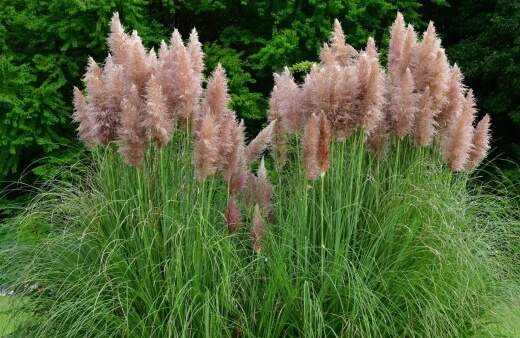 |
Cortaderia selloana ‘Sunningdale Silver’Sporting stunning silvery plumes, this variety has naturally become highly sought after. This is a larger growing plant, reaching up to 3 metres tall and wide even in gardens. |  Source: johnstowngardencentre.ie |
Cortaderia selloana ‘Pumila’

Commonly referred to as dwarf pampas grass, this compact cultivar only grows to about 1.5 metres tall and wide. It is therefore a great option for container growing within gardens. It features plumes that offer soft-yellow to ivory hues.
Cortaderia selloana ‘Rendatleri’

Another brilliant cultivar, this plant produces eye-catching pink feathery plumes atop dark-green foliage. It grows up to 2.5 metres tall and wide.
Cortaderia selloana ‘Sunningdale Silver’

Source: johnstowngardencentre.ie
Sporting stunning silvery plumes, this variety has naturally become highly sought after. This is a larger growing plant, reaching up to 3 metres tall and wide even in gardens.


Get Your Free Guide:
Master Growing Australian Natives eBook
A Must Have Complete Guide for Every Australian Garden
Get Your Free Guide:
Master Growing Australian Natives eBook
A Must Have Complete Guide for Every Australian Garden
How to Grow Pampas Grass
You can grow pampas grass from seed or easily propagate it using division thanks to its grassy rhizome root system. It is best to plant in spring and this plant will need lots of space to grow and thrive.
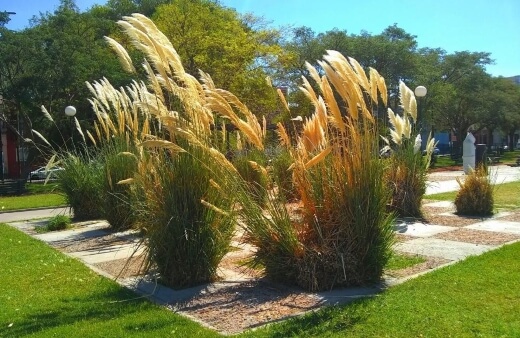
If you’re intending on establishing more than one plant, it is best to then plant them 2 to 3 metres apart so each has a sufficient amount of room to grow and spread.
Being a perennial, pampas grass will enter dormancy in winter but will come back in spring.
Planting Pampas Grass
Here are some of the ideal planting and growing conditions for pampas grass.
- Ideal Lighting - Full sun is best when growing but they can tolerate partial shade as well. Too much shade can create environments that are too damp which can quickly lead to fungal issues.
- Soil Preference - Loamy, moist soil that is well-draining is preferred. The pH can be neutral to slightly acidic. Enrich your soil before planting with some compost and add a fresh layer annually in spring.
- Temperature & Humidity - These grassy plants naturally thrive in hot and humid climates. They are extremely hardy though so they can also withstand cold winters, frost and even snow. They suit most of our endemic climates well.
How to Propagate Pampas Grass
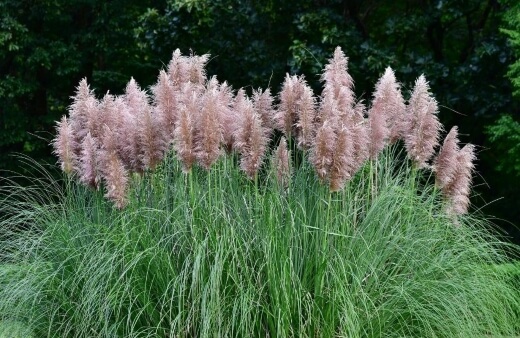
Growing Pampas Grass from Seed
- Prepare small containers or seed trays filled with quality, well-draining rich soil or a high-quality seedling mix.
- Sow the seeds in spring just below the surface of the soil, only lightly covering them with soil.
- Using plastic wrap or a plastic dome, cover the pots to help increase the moisture and humidity.
- Place the seeds in a warm location that gets bright but indirect light.
- Keep slightly moist.
- Germination is usually speedy, often only taking 3 to 4 weeks.
- Once the seedlings have developed and are big enough to handle with care, you can repot them into larger containers so they can continue growing. (See this decorative outdoor gardening box for reference).
- Once the young plants start to take on a bushier appearance, they should be ready to be transplanted into their forever homes outdoors in spring.
- Flowering is rare in the first season so be patient and you’ll have a wonderfully flowering plant within about two years.
Propagating Using Division
- In late winter to spring after pruning your parent plant, gently lift it from the ground to expose the root system. You can even cut straight into the ground as well if you prefer.
- Using a sharp and sterilised spade or shovel, cut the root system and divide through the plant to create separate clumps. Each divided section should have a healthy number of roots, foliage and stems to grow from.
- Gently lift the separated clumps from the ground.
- Place the newly divided clumps into prepared planting holes in their own area. Use quality, well-draining soil and some compost to boost the existing ground.
Interested in home composting? Check out our review of the most reliable compost bins for 2023.
Caring for Pampas Grass
Generally, your plant should be simple to maintain and care for once established. They are tolerant to wind, drought and salty coastal conditions.

How to Prune Pampas Grass
This vigorous grower will need to be pruned annually to control its size and shape. Prune your plant all the way to the ground in late winter to early spring. This will help to keep the surrounding soil and area clear and encourage new growth each season.
Be sure to always wear protective gloves and gear when pruning as this plant does have very sharp grass blades. Eye protection and long pants and sleeves are also highly recommended when dealing with this plant.
See our compilation of the best gardening attire in Australia for 2023 for your gardening needs.
Watering Routine
Established grass should get enough water from rainfall. They are drought tolerant but in cases of extremely dry and hot conditions, some supplemental water may be needed.
New plants will need to be watered deeply after planting and may need the odd watering to aid in their initial growth.
Fertilising Pampas Grass
Though not entirely necessary, you can add a well-balanced garden fertiliser (like an 8-8-8) after pruning annually in late winter to early spring. Be sure to follow up with a good watering.
Cortaderia selloana Pests & Diseases
This species is very resistant to most pest or disease problems. In certain conditions, mites and aphids may pose a problem. They are tiny insects that will suck the life out of your plant, leaving it looking wilted and yellow.
You can try knocking them off the plant by spraying them with water. Alternatively, applying an insecticide or neem oil will also help rid your plant of infestations.
Pampas Grass Frequently Asked Questions
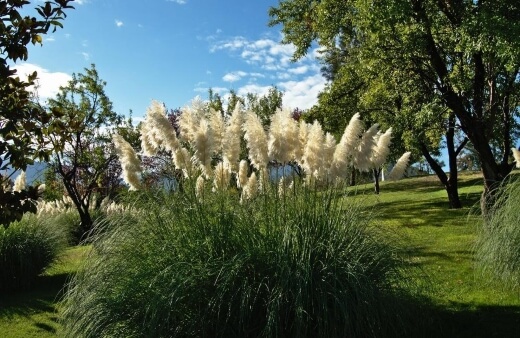
Can you grow pampas grass in Australia?
Yes, you can in certain areas. The plant has naturalised itself in bushland on the central coast and in many areas of the Central Tablelands. It is considered a major weed in Sydney but there are plenty of small populations along the north coast of NSW.
How deep do pampas grass roots grow?
The root systems are also vigorous growers and can grow up to 3.5 metres in depth.
How do I make my pampas grass fluffy?
The more full sun this plant gets, the fluffier the plumes will be. This is why full sun positions are recommended over shadier spots in the garden.
Create Picturesque Outdoor Spaces with Pampas Grass
A truly lush and ornamental flowering plant, pampas grass is the perfect pick for growers who have the space and desire to establish a more textured appeal in their outdoor areas.
The large fluffy and feathery cream flowers atop luscious grassy foliage can quickly elevate your landscape and provide you with a truly unique experience as a gardener.
With other stunning cultivars of pampas grass available, you’re bound to find the right fit for your needs.

Published on July 6, 2022 by Maisie Blevins
Last Updated on October 4, 2024




